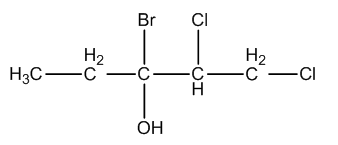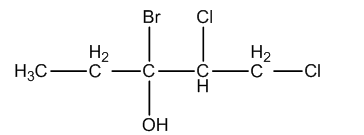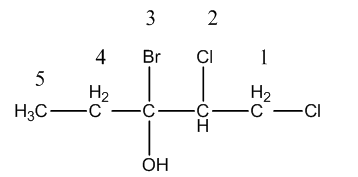
The IUPAC name of the compound is:

A. 3-Bromo-4,5-dichloropentan-3-ol
B. 3-Bromo-1,2-dichloro-3-hydroxypentane
C. 3-Bromo-1,2-dichloropentan-3-ol
D. 3-Bromo-4,5-dichloro-3-hydroxypentane

Answer
506.4k+ views
1 likes
Hint: According to IUPAC (International Union of Pure and Applied Chemistry), whenever we are going to write the name of the compound, we have to give numbering first to functional groups. Means lower numbering should become a functional group present in the molecule or compounds.
Complete step by step answer:
Whenever we are going to write the IUPAC name, we should identify the parent chain or long chain in the given compound and we have to identify the functional groups present in the given compound.
In the given molecule, one bromine atom, two chlorine atoms, one alcohol functional group are present.

After numbering the structure of the given molecule is as follows.

On carbon-1 and on carbon-2, chlorine atoms are present, on carbon-3 one bromine and one alcohol functional group is present.
Coming to given options, option A, 3-Bromo-4,5-dichloropentan-3-ol. The option A is wrong because the chlorine atoms are present on carbon-1 and carbon-2.
Coming to option B, 3-Bromo-1,2-dichloro-3-hydroxypentane. The option B is wrong because the alcohol functional group should not be named as hydroxyl.
Coming to option D, 3-Bromo-4,5-dichloro-3-hydroxypentane. The option D is wrong because the chlorine atoms are on carbon-1 and carnbon-2 and alcohol group is present in the given molecule.
So, the correct option is, option c. 3-Bromo-1,2-dichloropentan-3-ol
Note: Don’t be confused while giving numbering and names to the functional groups.
The carbon which is attached to functional groups should be number first and we have to identify the longest carbon chain in the given compound.
Complete step by step answer:
Whenever we are going to write the IUPAC name, we should identify the parent chain or long chain in the given compound and we have to identify the functional groups present in the given compound.
In the given molecule, one bromine atom, two chlorine atoms, one alcohol functional group are present.

After numbering the structure of the given molecule is as follows.

On carbon-1 and on carbon-2, chlorine atoms are present, on carbon-3 one bromine and one alcohol functional group is present.
Coming to given options, option A, 3-Bromo-4,5-dichloropentan-3-ol. The option A is wrong because the chlorine atoms are present on carbon-1 and carbon-2.
Coming to option B, 3-Bromo-1,2-dichloro-3-hydroxypentane. The option B is wrong because the alcohol functional group should not be named as hydroxyl.
Coming to option D, 3-Bromo-4,5-dichloro-3-hydroxypentane. The option D is wrong because the chlorine atoms are on carbon-1 and carnbon-2 and alcohol group is present in the given molecule.
So, the correct option is, option c. 3-Bromo-1,2-dichloropentan-3-ol
Note: Don’t be confused while giving numbering and names to the functional groups.
The carbon which is attached to functional groups should be number first and we have to identify the longest carbon chain in the given compound.
Latest Vedantu courses for you
Grade 7 | CBSE | SCHOOL | English
Vedantu 7 CBSE Pro Course - (2025-26)
School Full course for CBSE students
₹45,300 per year
Recently Updated Pages
Master Class 9 General Knowledge: Engaging Questions & Answers for Success

Master Class 9 English: Engaging Questions & Answers for Success

Master Class 9 Science: Engaging Questions & Answers for Success

Master Class 9 Social Science: Engaging Questions & Answers for Success

Master Class 9 Maths: Engaging Questions & Answers for Success

Class 9 Question and Answer - Your Ultimate Solutions Guide

Trending doubts
State and prove Bernoullis theorem class 11 physics CBSE

Who built the Grand Trunk Road AChandragupta Maurya class 11 social science CBSE

1 ton equals to A 100 kg B 1000 kg C 10 kg D 10000 class 11 physics CBSE

State the laws of reflection of light

One Metric ton is equal to kg A 10000 B 1000 C 100 class 11 physics CBSE

Difference Between Prokaryotic Cells and Eukaryotic Cells




